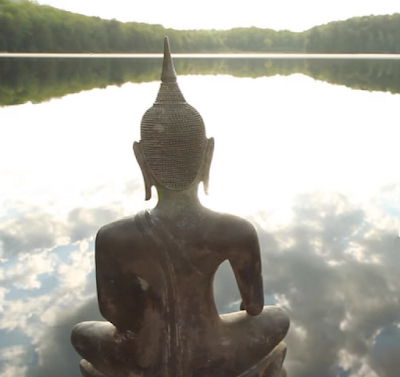Bettany Hughes (BBC Teach) edited by Dhr. Seven (ed.), Wisdom Quarterly
1. What is meditation?
 |
| The Buddha in gold, Thai Theravada temple |
- [NOTE: There are three kinds of buddhas, we could say, (1) an enlightened disciple of a teaching Buddha, an arahant or arhat, (2) a nonteaching or pacceka-buddha, and (3) a super rare supremely awakened one (samma-sam-buddha). The historical Buddha (born Prince Siddhartha Gautama) and often called Shakyamuni ("the Sage of the Scythians or Shakyas") was the third kind.]
.jpg) |
| Westerners in India in the 1960s: Dipa Ma |
Meditation already existed in the Brahminical Vedic tradition, and the Buddha himself used samadhi meditation as the basis of his enlightenment, which only became possible with the addition of mindful-insight practices, later referred to as vipassana.
Over the centuries Buddhism has evolved many different techniques: for example, koans, visualization, Pureland, vows, and tariki (other-powered) prayers and petitions.
A skilled meditation teacher can pass on specific techniques according to individual needs.
Various schools of Buddhism use meditation in different ways.
In a Tibetan Vajrayana tradition, meditators might use a mantra, which is repeated to help focus their mind and which embodies the truth of the Buddhist teaching.
In a Theravada tradition, mindfulness might be developed by paying attention to the breath, or to feelings, mind, or mind-objects (satipatthana).
The mind has mental states as well as a current of ideas and images moving through consciousness as meditators sit and impersonally observe these things. But what Buddhists get from meditation is more than just calm. That is the first step. What is needed beyond that is liberating-insight.
2. Meditation, step by step
Mastering the basics: Breathing and posture
One must be comfortable to meditate. If it helps, use a cushion or chair. The natural curve to the spine should allow the diaphragm to move freely as one breathes in and out. Allow attention to settle and focus on the breath moving in and out of the tip of the nose.
As one becomes more settled, attentive, and concentrated, one may experience a refreshing state of rapture (piti), bliss, effervescence, natural clarity, and single-pointedness. That’s how the path to enlightenment started for the wandering ascetic Siddhartha himself.
4. Finding nirvana
Bettany Hughes explains how the Buddha used meditation to find enlightenment.
Bettany Hughes explains how the Buddha used meditation to find enlightenment.
5. Difference between prayer and meditation
 |
| Tibetan with prayer wheel in Lhasa |
From the outside some people think that meditation looks like prayer. Prayer is about petitioning a higher power, usually a deity, and worshipping it. People pray (petition) for different reasons, sometimes to serve a deity, sometimes to express their beliefs, or sometimes to ask for help.
Meditation is about the guided transformation of the practitioner through one's own effort. This is easy to see with mindfulness:
One simply pays bare attention (dispassionate, detached, unbiased) to one's own body and mind.
 |
| Meditation is the best thing one can do. |
But even in Tibetan Vajrayana Buddhism, where the meditator might visualize a Cosmic Buddha, or a goddess, or a wrathful deity, or a being liberated from suffering, there is still an understanding that that picture is created by the mind and imagination, that ultimately the meditator is appealing to one's own higher potential for assistance.
A Buddha seen in meditation is understood to be transient, just like everything else in human experience.
A Tibetan pilgrim in Lhasa using a prayer wheel.
A Tibetan pilgrim in Lhasa using a prayer wheel.
6. How can we meditate in our everyday lives?
Here are a few examples of how meditation is being used in the secular world.
Education and meditation
 |
| Dr. Seldon, Jenny Edwards CBE, Paul Wride |
Stress and meditation
Jenny Edwards CBE, Mental Health Foundation: "Mindfulness meditation helps people change the way they think and feel about their experiences, especially stressful ones. By paying attention to your thoughts and feelings you become more aware of them and better able to manage them. Mindfulness helps induce relaxation, which is a physiological response that slows heart rate, drops blood pressure, and decreases the levels of stress hormones."
Prison and meditation
A prisoner at HMP [Her Magesty's Prison] Wymott: "Meditation practice is working for me. It helps me to be calm, relaxed, and not get angry and irritated. It helps me not react to people in a bad way and to take people’s opinion on board. Recently, when someone went a bit too far, instead of reacting to it, I just walked away."
Later life and meditation
 Paul Wride, 64-year-old retiree: "I’ve been meditating for 15 years but not continuously. I think it helps you to calm down, appreciate things around you, and deal with life’s tribulations. To anyone thinking about meditating, I’d say try it, particularly mindfulness because it's not difficult, you’ve got nothing to lose."
Paul Wride, 64-year-old retiree: "I’ve been meditating for 15 years but not continuously. I think it helps you to calm down, appreciate things around you, and deal with life’s tribulations. To anyone thinking about meditating, I’d say try it, particularly mindfulness because it's not difficult, you’ve got nothing to lose." |
| Why do Buddhists meditate? - BBC Teach (Bettany Hughes) |



























































































































































































































































No comments:
Post a Comment